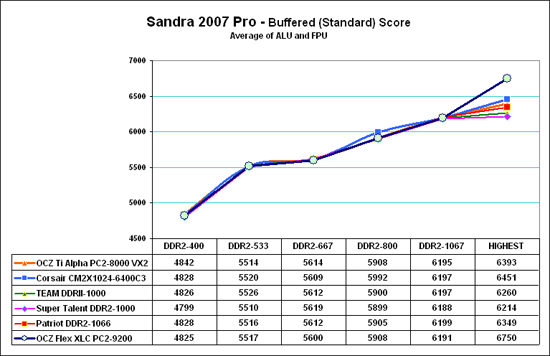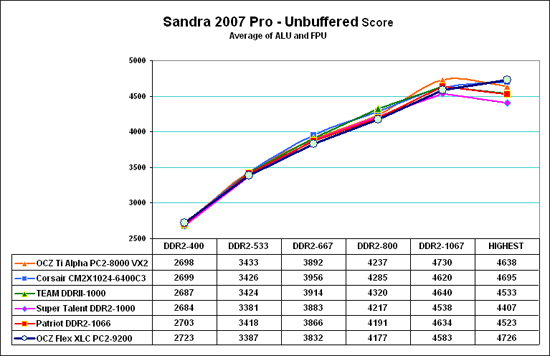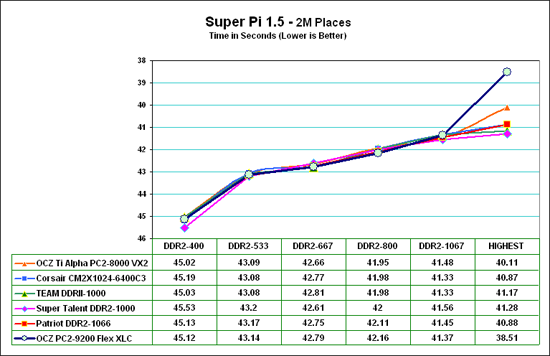OCZ Flex XLC: PC2-9200 Pushes the Envelope
by Wesley Fink on December 8, 2006 8:00 PM EST- Posted in
- Memory
Memory Bandwidth Scaling
Memory bandwidth normally improves with increases in memory speed and reductions in memory timings. This is best illustrated using Performance Scaling charts instead of Bar charts for individual speeds.
Since the results for high-end memory are so close at all tested speeds, the scale range was reduced to better show the small differences in these memory benchmark results. Please keep this in mind when viewing the charts, since a normal zero scale would make performance differences appear much smaller than these expanded scale charts. Values for the tested DIMMs at each speed are included below each chart for reference.
To evaluate memory bandwidth SiSoft Sandra 2007 Professional was used to provide a closer look at scaling for fast DDR2 memory.

The most widely reported Sandra score is the Standard or Buffered memory score. This benchmark takes into account the buffering schemes like MMX, SSE, SSE2, SSE3, and other buffering tools that are used to improve memory performance. The Buffered benchmark does not correlate well with real performance differences in games, so our memory bandwidth tests have always included an Unbuffered Sandra memory score. The Unbuffered result turns off the buffering schemes, and we have found the differences in Unbuffered results correlate well with real-world performance differences.

In both Buffered and Unbuffered tests we see the OCZ Flex XLC mirrors the best memory tested to DDR2-1066. This is exactly what would be expected since the Flex XLC is based on the same core memory chip as the other tested memories. Memory bandwidth increases dramatically at the top in buffered bandwidth (standard test). This is mostly a result of the much higher overclock in memory that could be achieved with the OCZ PC2-9200 Flex XLC compared to other Micron D-based memory. Unbuffered results also increase at the top speed, but not as dramatically as buffered results. This is also the expected result.
A look back at the page 4 tables will show that where we tested with the same CPU speed at the highest memory overclock the bandwidth increases at DDR2-1192 are smaller. The bandwidth increases at the default 2.93 GHz speed are strictly the result of increased memory speed, as CPU speed is eliminated as a variable.
We also compared results with Version 1.5 of Super Pi - comparing the time to calculate 2 million places of Pi at the different memory speeds. This benchmark measures pure number crunching.

Super Pi results continue to improve all the way to the highest speed that could be reached with stability with each memory. The second result that stands out is how close the results with all the memories really are from DDR2-400 to DDR2-1066. This is mainly a reflection of the fact that compared memories are based on the same base Micron memory chips. At the highest speed Flex XLC pulls away from the pack with the record DDR2-1172 overclock. However, the 1172 top speed at stock 2.93 GHz is very close to DDR2-1067 results. These two results show the impact of CPU speed on calculation performance is much greater than the impact of memory speed increases.
Memory bandwidth normally improves with increases in memory speed and reductions in memory timings. This is best illustrated using Performance Scaling charts instead of Bar charts for individual speeds.
Since the results for high-end memory are so close at all tested speeds, the scale range was reduced to better show the small differences in these memory benchmark results. Please keep this in mind when viewing the charts, since a normal zero scale would make performance differences appear much smaller than these expanded scale charts. Values for the tested DIMMs at each speed are included below each chart for reference.
To evaluate memory bandwidth SiSoft Sandra 2007 Professional was used to provide a closer look at scaling for fast DDR2 memory.

The most widely reported Sandra score is the Standard or Buffered memory score. This benchmark takes into account the buffering schemes like MMX, SSE, SSE2, SSE3, and other buffering tools that are used to improve memory performance. The Buffered benchmark does not correlate well with real performance differences in games, so our memory bandwidth tests have always included an Unbuffered Sandra memory score. The Unbuffered result turns off the buffering schemes, and we have found the differences in Unbuffered results correlate well with real-world performance differences.

In both Buffered and Unbuffered tests we see the OCZ Flex XLC mirrors the best memory tested to DDR2-1066. This is exactly what would be expected since the Flex XLC is based on the same core memory chip as the other tested memories. Memory bandwidth increases dramatically at the top in buffered bandwidth (standard test). This is mostly a result of the much higher overclock in memory that could be achieved with the OCZ PC2-9200 Flex XLC compared to other Micron D-based memory. Unbuffered results also increase at the top speed, but not as dramatically as buffered results. This is also the expected result.
A look back at the page 4 tables will show that where we tested with the same CPU speed at the highest memory overclock the bandwidth increases at DDR2-1192 are smaller. The bandwidth increases at the default 2.93 GHz speed are strictly the result of increased memory speed, as CPU speed is eliminated as a variable.
We also compared results with Version 1.5 of Super Pi - comparing the time to calculate 2 million places of Pi at the different memory speeds. This benchmark measures pure number crunching.

Super Pi results continue to improve all the way to the highest speed that could be reached with stability with each memory. The second result that stands out is how close the results with all the memories really are from DDR2-400 to DDR2-1066. This is mainly a reflection of the fact that compared memories are based on the same base Micron memory chips. At the highest speed Flex XLC pulls away from the pack with the record DDR2-1172 overclock. However, the 1172 top speed at stock 2.93 GHz is very close to DDR2-1067 results. These two results show the impact of CPU speed on calculation performance is much greater than the impact of memory speed increases.










29 Comments
View All Comments
snout - Tuesday, January 23, 2007 - link
I would like to see the ocz up against the Team Group Extreme 800 mhz c3 sticks at 3.3.3.8. The memory choices at test make it (ocz) look better than it is.ZOOAIRZ - Saturday, December 30, 2006 - link
Reguarding article:http://www.anandtech.com/memory/showdoc.aspx?i=288...">http://www.anandtech.com/memory/showdoc.aspx?i=288...
Quote:
"On the nForce 680i the OCZ Flex XLC took DDR2 memory performance to a new gold standard. On Air Cooling, Flex XLC reached DDR2-1300 at the rated timings of 5-5-5-18."
OCZ Flex with the following stable ratios:
1) cpu: 3.22 (11x293) FSB: 1172 - linked 1 to 1 - RAM: 1172 Quake4 FPS: 127.3
2) cpu: 3.03 (7x433) FSB: 1733 -unlinked 1.3 to 1- RAM: 1300 Quake4 FPS: 122.1
Say one then ups the multiplier as follows and assume it is stable:
1) cpu: 3.52 (12x293) FSB:1172 - linked 1 to 1 - RAM: 1172 Quake4 FPS: ?
2) cpu: 3.46 (8x433) FSB:1733 -unlinked 1.3 to 1- RAM: 1300 Quake4 FPS: ?
Which combo is better/faster overall?
- 1) Linked (fast) FSB and RAM with slightly higher (+.05GHz) CPU speed
or
- 2) Unlinked (raging) FSB and RAM with slightly lower CPU speed?
This question comes from the following statement found in this article:
http://www.pcpro.co.uk/phpbb/viewtopic.php?t=17384...">http://www.pcpro.co.uk/phpbb/viewtopic.php?t=17384...
Quote:
Now you have your OCed system. Here is something to remember a
processor running 200*10 =2000MHz and a processor running
210*9.5=1995MHz yet the second is faster because its running a faster
FSB so it has more memory bandwidth.(note that if you have to use a
slower ram speed i.e. using the FSB:RAM ratio of 5:4 you wipe out this
increase in bandwidth)
I don't see a FSB:RAM ratio 1.3 : 1 wiping out too much bandwidth but I just don't know. I am just interested in the overall good of playing my favorite games And getting the most out of a PC. If gettting that crazy 1300 speed of the memory just sets a record, that doesn't do it for me.
Thanks in advance.
Gannon - Thursday, December 14, 2006 - link
Could we get better simpler graphs when doing these comparisons? I hate looking at having just these charts, the overlapping colored lines and dots are useful for analysis but not for someone who's time is valuable and simply wants to know whats the best at a glance and thats what you guys should be doing! Serving your users the information they want in the way they want it. Anyone interested in performance is going to go for the highest performing ram, but it's also good for those of us curious to be able to tell at a glance what different ram will buy us.i.e. the way firingsquad does graphs or the way you do it ususally when comparing FPS between video cards would be just as useful.
Beachboy - Saturday, December 9, 2006 - link
This OCZ Flex RAM is the equivalent of a chrome exhaust-pipe extension on a Hyundai... a $490 one that is, lol.Wesley Fink - Sunday, December 10, 2006 - link
For the Hyundai analogy to make sense we would have to have a BMW in DDR2 memory. The Flex XLC is as good as it gets, so it is the BMW even though it doesn't go a lot faster. The chrome exhaust extension on the Hyundai would be a matched pair of 2GB value dimms based on Elpida memory chips with flashy heatsinks. You will reach DDR2-800 just fine, but nothing over about 900. It will definitely get the job done.Of course the BMW isn't only about speed, and luxury cars sell well despite the fact that you probably would have a hard time justifying "value per dollar" on anything more than a Japanese V6. Some buyers want the handling and flexibility that comes with the best.
yyrkoon - Sunday, December 10, 2006 - link
I agree with your analogy for the most part. I guess the only real question is: "is it worth buying". Which of course, you've already answered in the article.I would think this memory would be perfect for you guys, in testing potential OC's of systems you're reviewing, other than that, IMO, it would be a waste of money.
</my_two_cents>
Wesley Fink - Sunday, December 10, 2006 - link
The Flex XLC actually DOES go a LOT faster, so the BMW analogy applies, but you don't get similarly big gains in performance with the big speed increases since our DDR2 processors are not particularly sensitive to memory bandwidth.It's sort of like a world where a 500 horse power engine doubles your speed, but 80% of the speed increase just goes to fighting the incresed head wind. It does not mean the Flex XLC is not a good design, because it definitely is as good as it gets in current DDR2 designs.
Avalon - Saturday, December 9, 2006 - link
It seems to me that it was the 680i that allowed the OCZ Flex to reach an outstanding DDR2-1300, so why not test previous memory modules to see how much further they'd also get on the new Nvidia platform? It seems only fair.Wesley Fink - Saturday, December 9, 2006 - link
We also tested on our standard platform - the Asus P5W-DH Deluxe - where the Flex reached DDR2-1172 on air cooling. That was the highest ever on that platform - the previous high was DDR2-1111. That was fair, which is why we tested on the current memory test bed.As we said in the review, we will add overclocking tests with the 680i going forward, but we will still do base testing with the 975x baord.
Avalon - Sunday, December 10, 2006 - link
Right, but my point was that many other modules might have a ton of additional headroom if placed into the 680i platform. I'm not contesting the fact that the Flex reached the highest speeds on the 975x, but that previous modules should be tested on the 680i to see how much of a difference it makes, not just for the Flex.